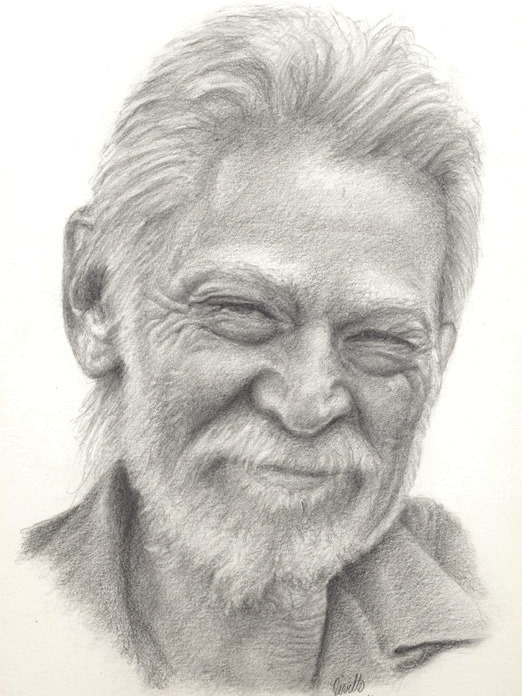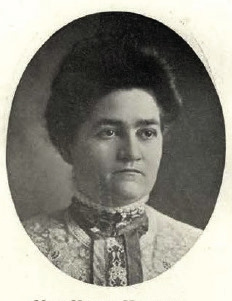Dr. Grady Early, Distinguished Professor Emeritus, taught math and computer science at Texas State University for 29 years, serving briefly as interim chair of the newly-formed Computer Science department. After retirement, Early began researching his family history and gained some familiarity with various research tools: ancestry, familysearch, newspapers, San Marcos Record archives, findagrave and many more. This made it easy for him to segue into the histories of non-family members, which is how he began to write a story about Southwest Texas Normal in San Marcos, also known as San Marcos Normal, which is now Texas State University. This series will highlight the first staff at Southwest Texas Normal.
According to the 1907 Pedagogue, Helen Marcella Hornsby was an advocate of a diet of “sauerkraut and Wienerwürstchen” and pumped German declensions into her clients’ heads by means of the famous “Nürnberger Trichter.”
Hornsby was born 1857 in Hornsby Bend, Travis County. Her father Malcolm Morrison Hornsby was a farmer; her mother Leanora Mc-Laurin had kids to raise — 13 of them, no twins.
Malcolm had been a sheriff of Travis County for three terms. In 1892, there was a dance on his farm in Travis County when a fight broke out between two individuals, one of which shot Malcolm; he lingered for four days, then died on Sept. 28. In 1906, Malcom’s estate was settled and Hornsby received almost 60 acres of the family farm.
Hornsby drifted through several personas. At birth, and in the 1880 census, she was Marcella Hornsby. Soon, she was Helen M., then she dropped the M. It’s no wonder she dropped it as Marcella means “warlike, martial.”
Hornsby received her public education in Austin, graduating from Austin High School in 1891. In 1895, she received her bachelor’s degree from UT and was a member of Phi Beta Kappa, America’s most prestigious honor society. In addition, she was recording secretary of the Young Women’s Christian Association. In 1908, she would be an officer, secretary, in the state YWCA. In 1916 she was a director. In 1911, she went to Eureka Springs, Ark. to attend a YWCA conference. Later, she joined the Sorosis Club.
In 1896, Hornsby was assigned to the Austin High School as a teacher. With her were future SWTN faculty Alfred Freshney, at the High School, Jessie Sayers, at West Austin, and Mary Stuart Butler as a Special Teacher — music. Those appointments persisted until 1903 when they were all tapped by Tom Harris to be among the first faculty at SWTN.
Some Austin school teachers may have been rich, but they didn’t get that way through teaching. Some typical salaries in 1901 were $88.23/ month for principals and $70 for 7th and 8th grade “lady teachers.” Gentlemen, after all, presumably had families to support.
While John Edward Pritchett was headmaster with a specialty in Latin, Hornsby was an assistant with a specialty in German.
Hornsby did not sever her association with UT; in 1904 she was secretary of the Alumni Association. Nor did she stop learning. In summer 1905, instead of working in one of the summer normals, she took a post graduate course in German in Madison, Wisconsin; probably at the University of Wisconsin. It was a short course; she left on June 24 and returned on Aug. 19. In Summer 1906, she took a trip to Europe. She repeated the trip to Madison in 1914. In 1917, she spent six weeks taking a course at the University of Chicago. She returned just in time to attend a party given by her brother Judge and Mrs. John W. Hornsby who entertained with a dinner party Wednesday evening to honor Governor and Mrs. W.P. Hobby. Others of the party were Judge Rudolph Kleberg and Stanley Hornsby, her nephew.
Hornsby was religious, and for prohibition, as was Tom Harris. And she was sociable.
The Comenian Society, ladies literary, was formed on Oct. 17, 1903; Hornsby was the sponsor and the driving force. When she married and left the college, Comenian ceased to exist.
At a 1910 Sunday School conference at the Methodist church in San Marcos, she and Dr. J.H. Combs discussed “The Organized Class.”
She was elected first vice president of the Fifth District Federation of Women’s Clubs. She gave a reception for the Brackenridge Club, the Sorosis Club and the Woman’s Club of San Marcos. In 1914, she was elected chairman of the modern language section of the Texas State Teachers’ Association.
In 1915 Hornsby and the German club gave a reception for Theodore Buehring who had examined students for the Sons of Hermann prizes. No doubt the language of choice was German.
Also in 1915, Hornsby directed a play “Die Hochzeitsreise,” which translates to “The Wedding Journey.” This involved folk dances in German peasant costumes. “This has come to be looked forward to annually by the German speaking people who come from the surrounding country and towns as one of the most attractive features of the [SWTN] commencement.”
Hornsby’s brother Judge William Hornsby’s home was the scene of Hornsby’s marriage to Charles Buchanan Crawford, a pioneering Texas cattleman on July 22, 1919. Hornsby retired from SWTN, and split her time between her home in San Marcos and Crawford’s ranch.
In 1921 Mrs. Helen Hornsby Crawford invited members of the families of the Reuben Hornsby section of the Daughters of the Republic of Texas to her home in San Marcos.
In 1930, Hornsby attended the funeral of Walter M. Robertson in Austin. Hornsby and her sister Amie lived with W.M. Robertson during their first year at UT.
Hornsby stayed busy with family and friends until Crawford died in 1952. A bright spot after that was in 1956. Hornsby had attended the 1896 wedding of Paul Rowe and Lou McLaurin, her niece. Now, Hornsby attended their 60th wedding anniversary.
In 1965, Hornsby died in San Marcos. Her students remembered her as kind, intellectual and fun-loving, whose tuneful accordion usually led the parade to the annual all-girls’ picnic at the head of the San Marcos River.
In recognition of her years of service and her impact on the school, Hornsby was honored with the construction of Helen Hornsby Hall, a girls dormitory, in 1951. The building lasted until 2019 when it was demolished to make way for Alamito & Cibolo Halls, two seven-story dormitories.
More information about her grave can be found at Findagrave # 20406358. Check out the virtual cemetery of the complete first faculty at findagrave.com/ virtual-cemetery/193 4255









